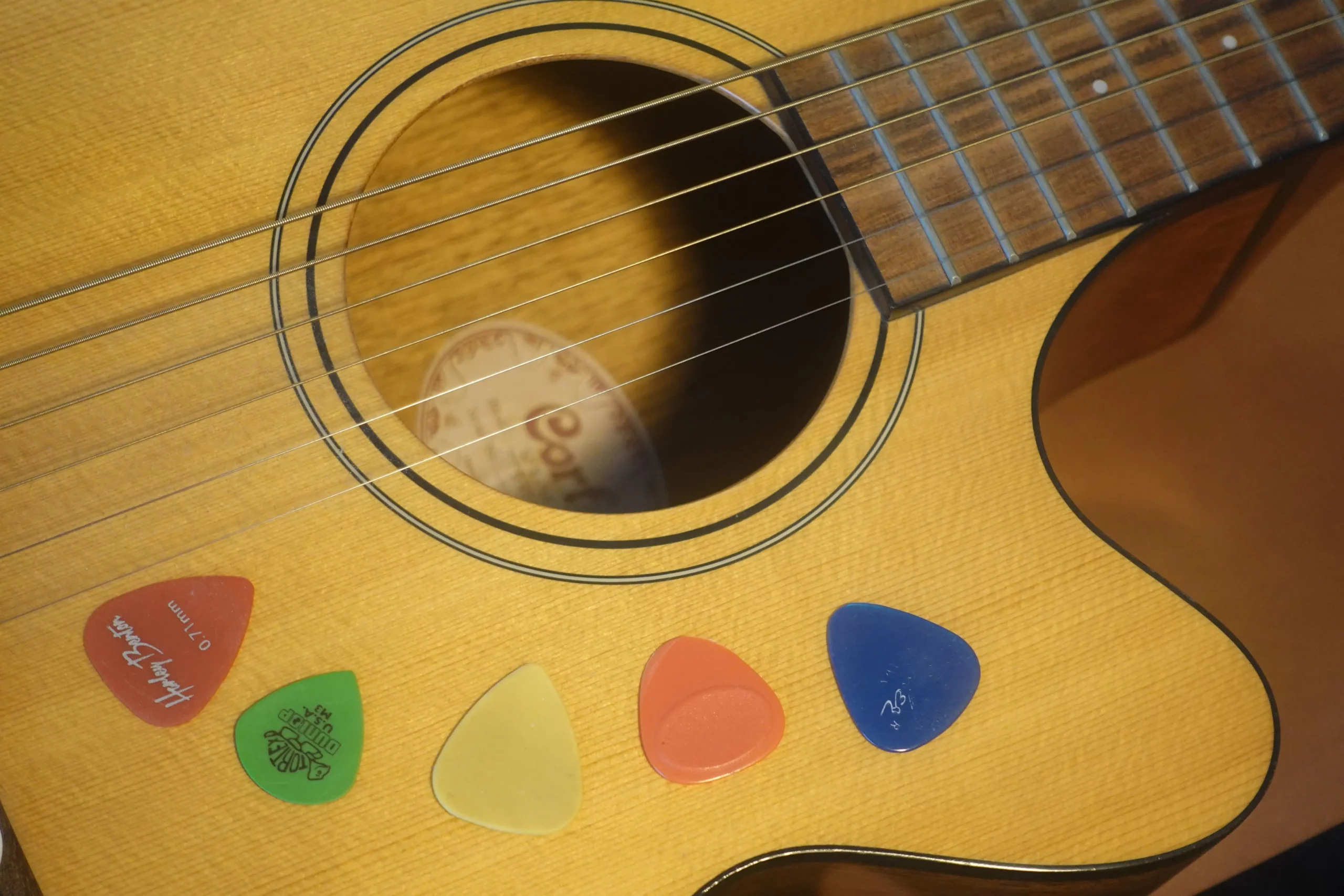Have you ever felt the thrill of listening to a classic song, and thought, “I wish I could play that on my guitar?” Well, guess what? Many of those songs aren’t as complicated as they sound.
Whether you’ve just picked up an acoustic guitar for the first time or are simply looking to expand your repertoire, you’re in for a treat. Today, we’re diving deep into acoustic guitar songs easy enough for beginners to pick up and play.
The Beauty of Simple Chord Progressions
Every great song, from rock songs to classic ballads, often hinges on simple chord progressions. As a beginner guitarist, the key is to first understand these chord progressions. This sets the foundation for an array of acoustic guitar songs.
Take “Free Fallin'” by Tom Petty. With just three chords – D, G, and A – this hit song becomes a go-to for many guitarists. Or consider the classic “Brown Eyed Girl” by Van Morrison, again utilizing the easy guitar song staple chords of G, C, and D. The magic lies not just in the chords themselves but how they’re strung together.
Bob Dylan, a master of crafting acoustic songs, uses these open chords to great effect in songs like “Blowin’ in the Wind” and “Knockin’ on Heaven’s Door”. Speaking of the latter, with just G, D, and Am, this acoustic guitar song is both haunting and accessible.
But First, The Basics
Before we dive into the list of songs, let’s brush up on the essentials. Mastering the guitar, be it acoustic guitar or electric guitar, begins with understanding the chord chart. Major chords like G, C, and D are often staples in easy guitar songs. But don’t be daunted by the occasional minor chord or the F chord, sometimes a tricky barre chord for beginners.
Learning strumming patterns is equally important. A song can change its feel entirely based on its strumming pattern. For instance, a staccato style strumming pattern gives a fun, peppy feel, perfect for songs like “Achy Breaky Heart” by Billy Ray Cyrus.
With a myriad of easy acoustic guitar songs out there, here are some of the top picks that beginner guitar players should consider:
“Nutshell” by Alice in Chains
Chords: Em, G, D, C
Learning to Play “Nutshell” by Alice in Chains on Acoustic Guitar
Alice in Chains, a band known for its deep, haunting melodies and profound lyrics, has given us some of the most memorable tracks in rock history. “Nutshell” stands out as one of those tracks that resonates deeply, not only because of its poignant lyrics but also due to its mesmerizing chord progression. The beauty of “Nutshell” is its simplicity, making it a great song for acoustic guitar beginners to learn.
Let’s dive into how beginners can learn to play “Nutshell” on an acoustic guitar.
Understand the Chords
Before getting into the song’s progression, let’s familiarize ourselves with the chords involved:
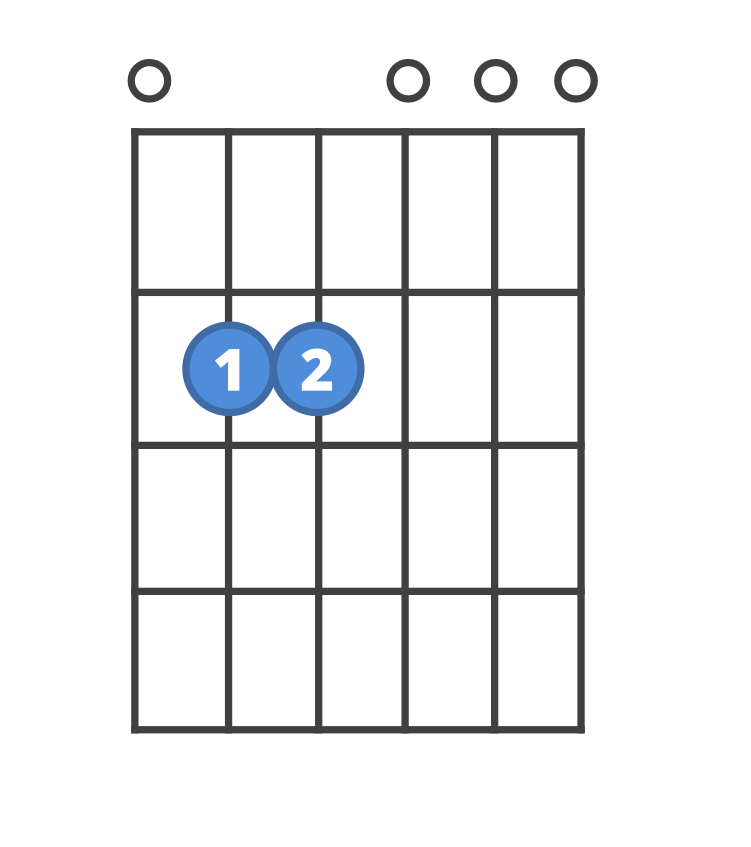
Em (E minor):
Place your middle finger on the 2nd fret of the 5th string (A string) and your ring finger on the 2nd fret of the 4th string (D string). Strum all the strings.
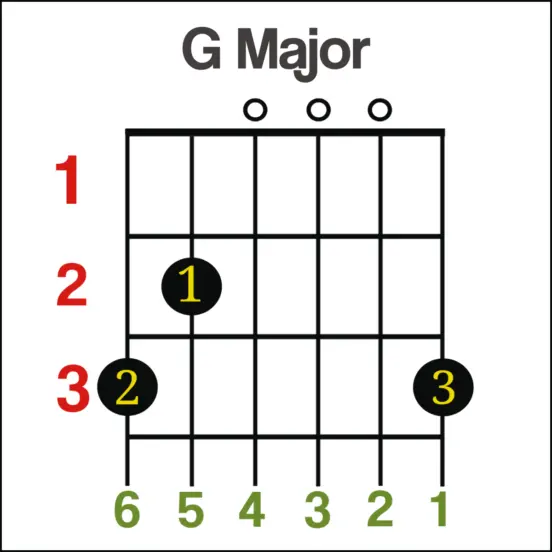
G:
Place your middle finger on the 3rd fret of the 6th string (E string), your index finger on the 2nd fret of the 5th string (A string), and your ring and pinky fingers on the 3rd frets of the 2nd (B string) and 1st (high E string) strings respectively. Strum all the strings.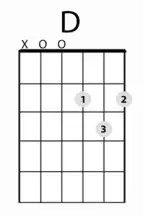
D:
Place your index finger on the 2nd fret of the 3rd string (G string), your ring finger on the 3rd fret of the 2nd string (B string), and your middle finger on the 2nd fret of the 1st string (high E string). Strum from the 4th string (D string) down.
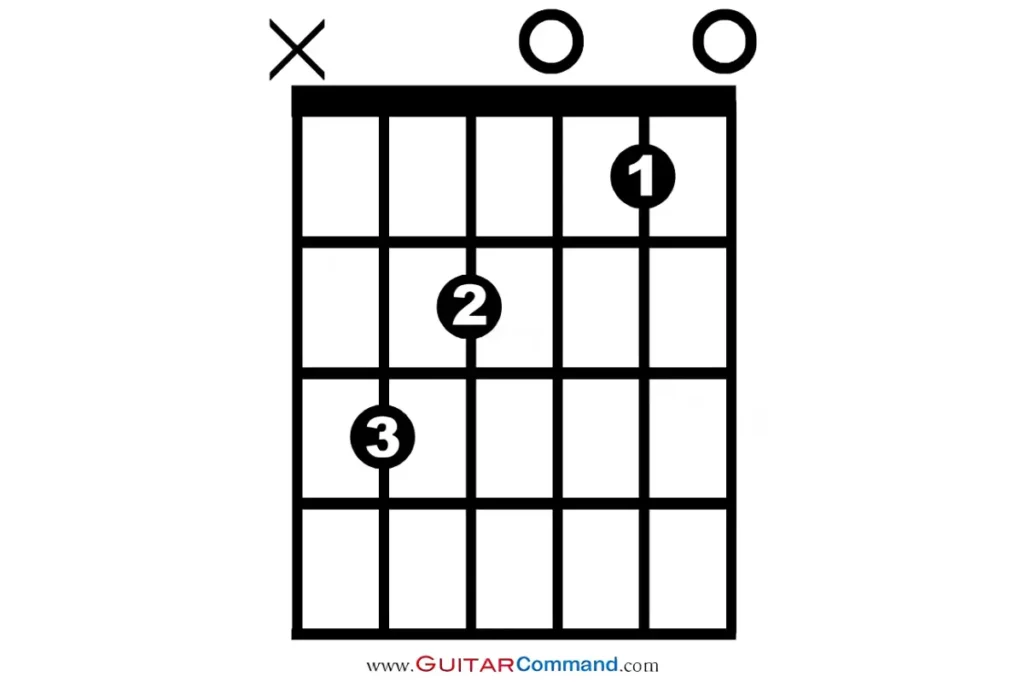
C:
Place your index finger on the 1st fret of the 2nd string (B string), your middle finger on the 2nd fret of the 4th string (D string), and your ring finger on the 3rd fret of the 5th string (A string). Strum from the 5th string (A string) down.
Strumming Pattern and Progression

The key to “Nutshell” is its somber, slow, and introspective feel. To achieve this, you’ll want a relaxed and flowing strumming pattern. A recommended strumming pattern for this song is: Down, Down, Up, Up, Down, Up.
Start by practicing this pattern separately with each chord until you get a feel for the rhythm.
Once you’re comfortable with the strumming, it’s time to integrate the chords. The progression for “Nutshell” predominantly revolves around the sequence: Em, G, D, C. This means that you’ll start by playing the Em chord, followed by the G, then D, and finally C, all while using the strumming pattern mentioned above.
Tips and Tricks
Smooth Transitions: One of the challenges for beginners is transitioning smoothly between chords. To overcome this, practice changing between these chords without strumming until you can do so effortlessly.
Listening: It’s a good idea to listen to the original song multiple times to understand the tempo, feel, and rhythm.
Pace Yourself: It’s more important to play correctly and smoothly than to play fast. Start slow and increase your speed as you become more comfortable.
Practice Regularly: Like any skill, playing the guitar requires consistent practice. Spend a dedicated amount of time each day practicing the chord changes and strumming pattern.
“Nutshell” by Alice in Chains is not just a beautiful song but also an excellent piece for beginners to expand their skills on the acoustic guitar. Its slow tempo, combined with the relatively easy chords, provides a perfect opportunity to hone one’s technique while also playing a classic rock anthem. So grab your guitar, find a quiet corner, and lose yourself in the magic of “Nutshell.”
“Wagon Wheel” by Old Crow Medicine Show
Chords: G, D, Em, C
A fun song that’s bound to be a hit at campfires.
Learning to Play “Wagon Wheel” by Old Crow Medicine Show on Acoustic Guitar
One of the ultimate campfire sing-alongs, “Wagon Wheel” by Old Crow Medicine Show, is an acoustic guitar favorite that every beginner should consider adding to their repertoire. With its catchy chorus, memorable melody, and straightforward chords, it’s a perfect song for those just starting on their guitar journey. Let’s embark on a step-by-step guide to mastering this classic tune.
Familiarize Yourself with the Chords
First things first, let’s break down the four chords used in “Wagon Wheel”:

G:
- Place your middle finger on the 3rd fret of the 6th string (E string).
- Your index finger goes on the 2nd fret of the 5th string (A string).
- Your ring and pinky fingers both land on the 3rd frets of the 1st (high E string) and 2nd (B string) strings respectively.
- Strum all the strings.

D:
- Your index finger is positioned on the 2nd fret of the 3rd string (G string).
- The ring finger goes on the 3rd fret of the 2nd string (B string).
- Your middle finger finds its place on the 2nd fret of the 1st string (high E string).
- Strum starting from the 4th string (D string) down.

Em (E minor):
- Place your middle finger on the 2nd fret of the 5th string (A string).
- Your ring finger sits on the 2nd fret of the 4th string (D string).
- Strum all the strings.

C:
- Your index finger is on the 1st fret of the 2nd string (B string).
- The middle finger rests on the 2nd fret of the 4th string (D string).
- Your ring finger is placed on the 3rd fret of the 5th string (A string).
- Strum starting from the 5th string (A string) down.
Strumming Pattern and Chord Progression
The beauty of “Wagon Wheel” lies in its repetitive and rhythmic strumming pattern. A suggested pattern for beginners is: Down, Down, Up, Down, Up.
This pattern will flow consistently throughout the song, making it relatively easy to maintain rhythm once you get the hang of it.
In terms of chord progression, the sequence is primarily: G, D, Em, C. This progression cycles through the verses and chorus, making it easy to follow once you’ve mastered the transitions.
Tips to Perfect Your Play
Transitioning Between Chords: To make your playing sound fluid, it’s vital to practice transitioning between the chords smoothly. Work on moving from G to D, D to Em, and Em to C until you can do it seamlessly.
Feel the Rhythm: Listen to the song multiple times. Tap your foot, nod your head, and immerse yourself in its rhythm. This will help you align your strumming with the song’s tempo.
Regular Practice: Like any song, mastering “Wagon Wheel” will require consistent practice. Dedicate time each day to go over the chords, transitions, and strumming pattern.
Play Along: Once you’re feeling confident, play along with the track. This will give you a sense of accomplishment and highlight areas you might need to work on.
Engage the Audience: Remember, “Wagon Wheel” is a campfire favorite. Encourage others to sing along and enjoy the communal experience of making music.
“Wagon Wheel” by Old Crow Medicine Show is an iconic song that resonates with audiences young and old. Its simple chord progression, coupled with a catchy melody, makes it a must-learn for beginner guitarists. So, tune up your acoustic guitar, gather around a campfire (or just a cozy corner), and let the strumming begin!
“Free Fallin” by John Mayer
D,G,A
A simple start for a beginner guitar player
Learning to Play “Free Fallin'” by John Mayer on Acoustic Guitar
When you think of soulful renditions and acoustic mastery, John Mayer’s cover of Tom Petty’s “Free Fallin'” definitely stands out. A beautiful track with its gentle progression and heartfelt lyrics, Mayer’s version brings a fresh perspective, making it a cherished piece for acoustic guitar enthusiasts.
If you’re a beginner looking to delve into this song, you’re in for a treat. Let’s walk through how you can bring “Free Fallin'” to life on your guitar.
Background
Before diving in, it’s essential to note that John Mayer’s rendition of “Free Fallin'” is a tribute to the original by Tom Petty. While the chord progression remains relatively the same, Mayer brings his unique touch, particularly in the live versions. This article will focus on the Mayer version, which is a bit more acoustic-friendly for beginners.
Chord Breakdown
The song predominantly revolves around three main chords: D, G, and A. If you’re new to these chords, here’s a quick guide:

D:
- Place your index finger on the 2nd fret of the 3rd string (G string).
- Your ring finger goes on the 3rd fret of the 2nd string (B string).
- Your middle finger sits on the 2nd fret of the 1st string (high E string).
- Strum from the 4th string (D string) down.
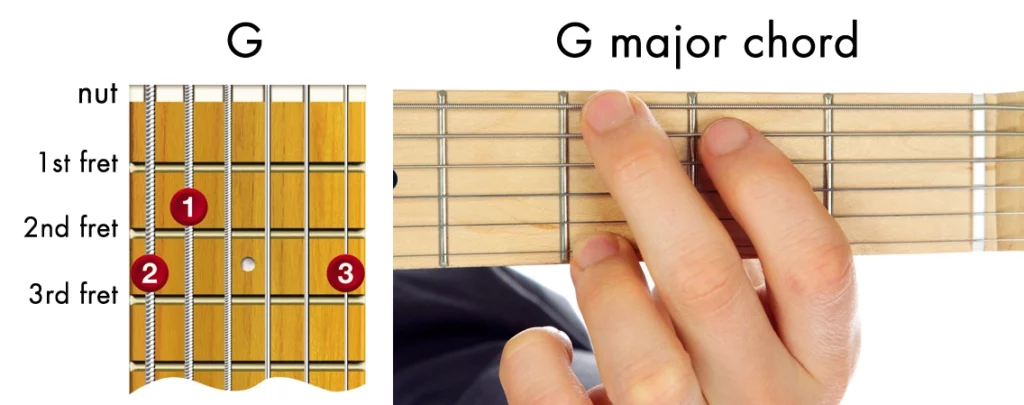
G:
- Your middle finger lands on the 3rd fret of the 6th string (E string).
- Place your index finger on the 2nd fret of the 5th string (A string).
- Your ring finger sits on the 3rd fret of the 1st string (high E string).
- Strum all strings.
A
- Your index finger is positioned on the 2nd fret of the 4th string (D string).
- Place your middle finger on the 2nd fret of the 3rd string (G string).
- Your ring finger goes on the 2nd fret of the 2nd string (B string).
- Strum from the 5th string (A string) down.
Strumming and Chord Progression
For “Free Fallin'”, you’ll find the strumming pattern to be relatively relaxed and straightforward. A suggested pattern for beginners is: Down, Down Up, Up, Down Up. This rhythm gives the song its laid-back and contemplative feel.
As for the progression:
- The verses maintain a sequence of D, G, D, A.
- The chorus shifts to G, D, A, D.
One of the beauties of this song is its repetitiveness, which allows beginners to focus on perfecting their strumming technique and chord transitions.
Enhancing Your Performance
Capo on the 3rd Fret: To match Mayer’s rendition, place a capo on the 3rd fret of your guitar. This will help you play along with the track and achieve the same tonality.
Practice Transitions: Move between the D, G, and A chords smoothly. Regularly practicing these transitions will help make your performance fluid.
Listen Actively: Play the song and listen. Familiarize yourself with its nuances, the rhythm, and Mayer’s unique style. The better you know the song, the more naturally it will come to you.
Express Yourself: The beauty of covers, even Mayer’s version, is that they’re interpretations. While it’s good to stick to the original, don’t shy away from adding your touch once you’re comfortable.
“Free Fallin'” by John Mayer (originally by Tom Petty) is a timeless piece that beautifully marries lyrics and melody. For beginners, it offers a fantastic opportunity to practice chord transitions, refine strumming techniques, and truly connect with a song’s emotion. So, grab your acoustic guitar, put your heart into every strum, and let “Free Fallin'” resonate!
“Ring of Fire” by Johnny Cash
Chords: G, C, D
This classic song is synonymous with acoustic guitar songs easy for beginners.
Mastering “Ring of Fire” by Johnny Cash on Acoustic Guitar
Ah, the unmistakable sound of Johnny Cash’s “Ring of Fire” – a timeless classic that has graced countless campfires, open mics, and guitar jam sessions for decades. The song, with its unique blend of country, rockabilly, and a hint of mariachi, is synonymous with acoustic guitar songs easy for beginners.
And the best part? It’s an excellent song for those just embarking on their guitar journey. Let’s dive into how a beginner can tackle this iconic tune.
An Intro to the Chords
To play “Ring of Fire,” you primarily need to familiarize yourself with three chords: G, D, and C chords. Here’s a simple breakdown:
- G:
- Middle finger on the 3rd fret of the 6th string (E string).
- Index finger on the 2nd fret of the 5th string (A string).
- Ring finger on the 3rd fret of the 1st string (high E string).
- Strum all strings.
- C:
- Index finger on the 1st fret of the 2nd string (B string).
- Middle finger on the 2nd fret of the 4th string (D string).
- Ring finger on the 3rd fret of the 5th string (A string).
- Strum from the 5th string (A string) downwards.
- D:
- Index finger on the 2nd fret of the 3rd string (G string).
- Ring finger on the 3rd fret of the 2nd string (B string).
- Middle finger on the 2nd fret of the 1st string (high E string).
- Strum from the 4th string (D string) downwards.
The Strumming Pattern and Chord Progression
One of the joys of “Ring of Fire” is its steady and rhythmic strumming pattern. A beginner-friendly pattern to follow is: Down, Down, Up, Down, Up. This pattern encapsulates the song’s rhythm and makes it easier to sing along as well.
For the chord progression:
- The verses mainly utilize: G, C, G, D, G.
- The chorus sticks to: G, C, G, D.
The repetitive nature of this progression makes “Ring of Fire” particularly accessible for beginner guitarists.
Tips for a Flawless Performance
Chord Transitions: Spend time practicing moving between the G, C, and D chords. Smooth transitions will elevate the song and make it sound more professional.
Rhythm is Key: Johnny Cash’s music is known for its distinctive rhythm. Ensure you maintain a steady beat when strumming to capture the song’s essence.
Sing Along: Once you’re comfortable with the chords and strumming, try singing along. The marriage of Cash’s deep vocals with the guitar’s resonance is a match made in heaven.
Embrace the Country Vibe: Remember, “Ring of Fire” is a country classic. Feel free to add a little twang to your strumming or vocals to stay true to its roots.
Practice with the Original: Play along with Johnny Cash’s version of the song. It will help you get a feel for the tempo, rhythm, and overall mood.
“Ring of Fire” by Johnny Cash is more than just a song; it’s a testament to the power of music and its ability to traverse time and genres. For beginner guitarists, this track offers a delightful blend of simplicity and depth, making it an essential addition to your acoustic repertoire. So, strap on your acoustic guitar, channel your inner Man in Black, and let the “Ring of Fire” ignite your musical passion!
“Achy Breaky Heart” by Billy Ray Cyrus
Chords: A, E, D
A straightforward song that’s a joy to play.
Strumming to the Beat of “Achy Breaky Heart” on the Acoustic Guitar
Embarking on a musical journey with your acoustic guitar in hand? You’re in for a treat as we explore how to play “Achy Breaky Heart” by Billy Ray Cyrus. Not only is this song a classic that gets feet tapping, but it’s also a straightforward track that’s a joy to play for beginners on the guitar. With its catchy melody and uncomplicated chord progressions, you’ll find yourself immersed in the rhythmic country vibes in no time.
Discovering the Chords
Here’s the lowdown on the three main chords you’ll need to familiarize yourself with:
- A:
- Middle finger on the 2nd fret of the 4th string (D string).
- Ring finger on the 2nd fret of the 3rd string (G string).
- Pinky finger on the 2nd fret of the 2nd string (B string).
- Strum from the 5th string (A string) down.
- E:
- Index finger on the 1st fret of the 3rd string (G string).
- Middle finger on the 2nd fret of the 5th string (A string).
- Ring finger on the 2nd fret of the 4th string (D string).
- Strum all strings.
- D:
- Index finger on the 2nd fret of the 3rd string (G string).
- Middle finger on the 2nd fret of the 1st string (high E string).
- Ring finger on the 3rd fret of the 2nd string (B string).
- Strum from the 4th string (D string) down.
Strumming Along
“Achy Breaky Heart” is celebrated for its upbeat and consistent rhythm, making it super accessible for beginners. A suitable strumming pattern for this song is: Down, Down Up, Up Down Up. Practicing this pattern will help you nail the upbeat vibe of the track.
The chord progression is blissfully simple too:
- The primary progression throughout the song is: A, E.
A Few Tips to Elevate Your Performance
Smooth Transitions: The key to mastering “Achy Breaky Heart” is ensuring your chord transitions between A, E, and occasionally D are smooth. Practice shifting between these chords until it becomes second nature.
Add Some Flair: Though the chord progression is simple, feel free to add some of your own flair. A little improvisation or additional strumming variations can make your rendition unique.
Sing It Out: If you’re up for it, belt out the lyrics as you strum along. Engaging with the vocal melodies can improve your rhythm and help you become a more versatile musician.
Play Along: To truly capture the essence of the song, play along with the original track. It can help you understand the nuances and distinctive style of Billy Ray Cyrus.
Keep It Fun: Remember, this is a fun and upbeat song. Let loose, enjoy the process, and don’t be afraid to get into the groove as you play.
“Chasing Cars” by Snow Patrol
Chords: C, G, Am, F
Just four chords, and you can sing along to this hit song.
Strumming Along to “Chasing Cars” by Snow Patrol on the Acoustic Guitar
If there’s one song that captures hearts with its emotive lyrics and melodious strums, it’s “Chasing Cars” by Snow Patrol. For those looking to embark on an acoustic guitar journey, this song is a delightful place to start. With its soulful rhythm, simple chord structure, and the fact that you need just four chords, you’ll soon be lost in the serenade of this classic ballad.
Getting Acquainted with the Chords
To master “Chasing Cars”, here’s a beginner-friendly guide to the four main chords:
- C:
- Index finger on the 1st fret of the 2nd string (B string).
- Middle finger on the 2nd fret of the 4th string (D string).
- Ring finger on the 3rd fret of the 5th string (A string).
- Strum from the 5th string (A string) down.
- G:
- Middle finger on the 3rd fret of the 6th string (E string).
- Index finger on the 2nd fret of the 5th string (A string).
- Ring finger on the 3rd fret of the 1st string (high E string).
- Strum all strings.
- Am (A minor):
- Index finger on the 1st fret of the 2nd string (B string).
- Ring finger on the 2nd fret of the 3rd string (G string).
- Middle finger on the 2nd fret of the 4th string (D string).
- Strum from the 5th string (A string) down.
- F:
- Index finger barring all strings on the 1st fret.
- Ring finger on the 3rd fret of the 5th string (A string).
- Pinky finger on the 3rd fret of the 4th string (D string).
- Middle finger on the 2nd fret of the 3rd string (G string).
- Strum all strings.
A Guide to the Strumming Pattern and Chord Progression
The song’s beauty lies in its gentle and consistent rhythm. For beginners, a fitting strumming pattern would be: Down, Down Up, Up Down Up.
The chord progression is repetitive, making it easier to grasp:
- The song mostly revolves around the pattern: C, G, Am, F.
Some Tips to Enhance Your Playing:
Practice Makes Perfect: The transition between chords, especially to the F chord (which is a barre chord), can be challenging. Dedicate time to practice transitioning smoothly between chords.
Emotion Over Perfection: Remember, “Chasing Cars” is an emotive song. Pour your feelings into the strums. It’s not about playing perfectly but playing with passion.
Sing Along: Once you’re comfortable with the chord transitions and strumming, try to sing along. Engaging with both the vocals and the instrument can be a rewarding experience.
Tune in to the Original: Play along with Snow Patrol’s version. It’ll give you a clearer sense of the song’s rhythm, tempo, and overall feel.
Keep the Rhythm: Ensure you maintain a consistent rhythm throughout. Using a metronome can be beneficial when starting out.
“Sweet Home Alabama” by Lynard Skynard
D, C, G
Simple guitar chords for those who have just started to play guitar.
Strumming the Sweet Tunes of “Sweet Home Alabama” on the Acoustic Guitar
There’s a timeless appeal to the Southern rock anthem, “Sweet Home Alabama” by Lynyrd Skynyrd. Its iconic riff and catchy chorus have made it a staple at parties, barbecues, and campfires. For aspiring guitarists, it’s a fantastic song to dive into.
Though it’s known for its lead guitar work, the rhythm section, which we’ll focus on, is perfect for beginners on the acoustic guitar. So, pull up a chair, grab your six-string, and let’s learn how to play this classic track!
Getting to Know the Chords
“Sweet Home Alabama” revolves around three primary chords:
- D:
- Index finger on the 2nd fret of the 3rd string (G string).
- Middle finger on the 2nd fret of the 1st string (high E string).
- Ring finger on the 3rd fret of the 2nd string (B string).
- Strum from the 4th string (D string) down.
- C:
- Index finger on the 1st fret of the 2nd string (B string).
- Middle finger on the 2nd fret of the 4th string (D string).
- Ring finger on the 3rd fret of the 5th string (A string).
- Strum from the 5th string (A string) down.
- G:
- Middle finger on the 3rd fret of the 6th string (E string).
- Index finger on the 2nd fret of the 5th string (A string).
- Ring finger on the 3rd fret of the 1st string (high E string).
- Strum all strings.
Mastering the Strumming and Progression
The strumming pattern for “Sweet Home Alabama” can be simplified for beginners as: Down, Down Up, Up Down. This rhythm captures the upbeat, feel-good vibe of the song.
As for the chord progression:
- The main progression of the song is: D, C, G.
Tips to Enhance Your “Sweet Home Alabama” Experience
Nail the Transitions: The song’s essence lies in the smooth transition between chords. Dedicate practice sessions to switching from D to C chord to G seamlessly.
Incorporate the Riff: Once you’re comfortable with the chords and rhythm, you can attempt the iconic opening riff of the song, which truly defines its character.
Play Along with the Track: Jamming with Lynyrd Skynyrd’s original can help you maintain tempo and imbibe the song’s authentic feel.
Feel the Groove: “Sweet Home Alabama” is a song of celebration and nostalgia. Embrace its mood, and let your playing reflect the joy and emotion it conveys.
Experiment with Dynamics: Try varying your strumming intensity. Strum softer during the verses and amp it up during the chorus for an added dynamic feel.
Engage Vocally: If you’re up to the challenge, sing along! It’s a fun song with memorable lyrics, and playing and singing simultaneously can elevate your performance.
“Sweet Home Alabama” is more than just a song. It’s an anthem, a celebration of the South, and a musical journey that resonates with many. For guitar beginners, it’s an excellent track to hone skills, understand chord progression, and indulge in the sheer pleasure of playing a universally beloved song.
As you strum those chords, remember to enjoy every note, every beat, and the essence of this iconic track. So, here’s to sweet tunes and even sweeter memories with “Sweet Home Alabama”!
“House of the Rising Sun” by The Animals
The song follows a distinct progression:
- Intro & Verses: Am, C, D, F, Am, C, E, E
- Chorus: Am, C, D, F, Am, E, Am, E
Mastering “House of the Rising Sun” on the Acoustic Guitar
One of the songs that evokes the timeless aura of classic rock and folk is “House of the Rising Sun” by The Animals. Known for its melancholic lyrics and iconic arpeggiated chords, it’s a must-learn for anyone picking up the acoustic guitar.
The good news? With a bit of patience and practice, even beginners can get the hang of this atmospheric song. Let’s delve into the world of New Orleans and explore how to play this classic on the acoustic guitar.
Setting the Stage with Chords
Before diving into the strumming and picking, you’ll need to get acquainted with the chords for “House of the Rising Sun.” Here they are:
- Am (A minor):
- Index finger on the 1st fret of the 2nd string (B string).
- Middle finger on the 2nd fret of the 4th string (D string).
- Ring finger on the 2nd fret of the 3rd string (G string).
- Strum from the 5th string (A string) down.
- C:
- Index finger on the 1st fret of the 2nd string (B string).
- Middle finger on the 2nd fret of the 4th string (D string).
- Ring finger on the 3rd fret of the 5th string (A string).
- Strum from the 5th string (A string) down.
- D:
- Index finger on the 2nd fret of the 3rd string (G string).
- Middle finger on the 2nd fret of the 1st string (high E string).
- Ring finger on the 3rd fret of the 2nd string (B string).
- Strum from the 4th string (D string) down.
- F:
- Index finger barring the 1st and 2nd strings on the 1st fret.
- Middle finger on the 2nd fret of the 3rd string (G string).
- Ring finger on the 3rd fret of the 4th string (D string).
- Strum from the 4th string (D string) down.
- E:
- Index finger on the 1st fret of the 3rd string (G string).
- Middle finger on the 2nd fret of the 5th string (A string).
- Ring finger on the 2nd fret of the 4th string (D string).
- Strum all strings.
Taking on the Progression
The song follows a distinct progression:
- Intro & Verses: Am, C, D, F, Am, C, E, E
- Chorus: Am, C, D, F, Am, E, Am, E
Strumming and Picking – The Song’s Essence
While many acoustic guitar players opt for a strumming approach, the true charm of “House of the Rising Sun” lies in its arpeggiated or picked chords. This means you’ll pick individual strings in a sequence rather than strumming them all together.
For beginners, it’s advisable to start with a basic down-strum pattern to get a feel of the progression. Once comfortable, dive into the world of picking to truly capture the song’s essence.
Tips for Success:
Practice the F Chord: For many beginners, the F chord can be a bit challenging. Dedicate some time to it. With practice, it will become easier.
Play Along: Once you’ve practiced the chord progression and picking pattern, try playing along with the original track to get a sense of timing and rhythm.
Feel the Emotion: “House of the Rising Sun” is drenched in emotion. Embrace its mood and narrative, allowing the story to guide your playing.
Final Thoughts
While this list offers a solid start, beginners are encouraged to explore more. For instance, the Rolling Stones have tracks with just three chords, making these easy songs learn, check out these resources:
As you progress, you’ll find that an easy acoustic guitar song might lead you to more complex tracks, perhaps even barre chords and Pink Floyd numbers!
To end, always remember the essence of playing the guitar: It’s not about how many songs you can play, but the joy and emotion you bring out in each chord progression, be it a simple chord progression played on an acoustic guitar or a complex one on an electric guitar.
Keep strumming, keep learning, and most of all, keep enjoying the journey.


